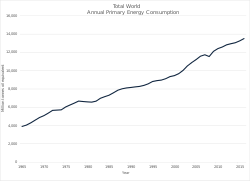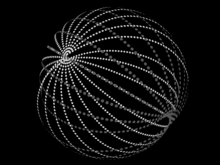Kardashev scale
Energy consumption estimated in three types of civilizations defined by the Kardashev scale
The Kardashev scale is a method of measuring a civilization's level of technological advancement based on the amount of energy they can use. The measure was proposed by Soviet astronomer Nikolai Kardashev in 1964.[1] The scale has three designated categories:
- A Type I civilization, also called a planetary civilization—can use and store all of the energy available on its planet.
- A Type II civilization also called a stellar civilization—can use and control energy at the scale of its planetary system.
- A Type III civilization also called a galactic civilization—can control energy at the scale of its entire host galaxy.
Definition
In 1964, Kardashev defined three levels of civilizations, based on the order of magnitude of power available to them:
Type I
The technological level of a civilization that is "close to the level presently attained on Earth, with energy consumption at ≈4×1019 erg/sec" (4×1012 watts).[1] Currently, the civilization of Type I is usually defined as one that can harness all the energy that falls on a planet from its parent star (for the Earth-Sun system, this value is close to 1.74×1017 watts), which is about four orders of magnitude higher than the amount presently attained on Earth, with energy consumption at ≈2×1013 watts. The astronomer Guillermo A. Lemarchand stated this as a level near contemporary terrestrial civilization with an energy capability equivalent to the solar insolation on Earth, between 1016 and 1017 watts.[2]
Type II
A civilization capable of harnessing the energy radiated by its own star—for example, the stage of successful construction of a Dyson sphere—with energy consumption at ≈4×1033 erg/sec.[1] Lemarchand stated this as a civilization capable of using and channeling the entire radiation output of its star. The energy use would then be comparable to the luminosity of the Sun, about 4×1033 erg/sec (4×1026 watts).[2]
Type III
A civilization in possession of energy at the scale of its own galaxy, with energy consumption at ≈4×1044 erg/sec.[1] Lemarchand stated this as a civilization with access to the power comparable to the luminosity of the entire Milky Way galaxy, about 4×1044 erg/sec (4×1037 watts).[2]
Kardashev believed that a Type 4 civilization was impossible, so he did not go past Type 3. However, new types (0, IV, V, VI) have been proposed.
Current status of human civilization
Total World, Annual Primary Energy Consumption.
According to the astronomer Carl Sagan, humanity is currently going through a phase of technical adolescence, "typical of a civilization about to integrate the type I Kardashev scale."
Further information: World energy consumption
At the current time, humanity has not yet reached Type 1 civilization status. Physicist and futurist Michio Kaku suggested that, if humans increase their energy consumption at an average rate of 3 percent each year, they may attain Type I status in 100–200 years, Type II status in a few thousand years, and Type III status in 100,000 to a million years.[3]
Carl Sagan suggested defining intermediate values (not considered in Kardashev's original scale) by interpolating and extrapolating the values given above for types I (1016 W), II (1026 W), and III (1036 W), which would produce the formula
{\displaystyle K={\frac {\log _{10}P-6}{10}}}
where value K is a civilization's Kardashev rating and P is the power it uses, in watts. Using this extrapolation, a "Type 0" civilization, not defined by Kardashev, would control about 1 MW of power, and humanity's civilization type as of 1973 was about 0.7 (apparently using 10 terawatts (TW) as the value for 1970s humanity).[4]
In 2018, the total world energy consumption was 13864.9 Mtoe (161,249 TWh),[5] equivalent to the average power consumption of 18.40 TW or 0.73 on Sagan's interpolated Kardashev scale.
Observational evidence
In 2015, a study of galactic mid-infrared emissions came to the conclusion that "Kardashev Type-III civilizations are either very rare or do not exist in the local Universe".[6]
In 2016, Paul Gilster, author of the Centauri Dreams website, described a signal apparently from the star HD 164595 as requiring the power of a Type I or Type II civilization, if produced by extraterrestrial lifeforms.[7] However, in August 2016 it was discovered that the signal's origin was most likely a military satellite orbiting the Earth.[8]
Energy development
See also: Energy development
Type I civilization methods[edit]
- Large-scale application of fusion power. According to mass-energy equivalence, Type I implies the conversion of about 2 kg of matter to energy per second. An equivalent energy release could theoretically be achieved by fusing approximately 280 kg of hydrogen into helium per second,[9] a rate roughly equivalent to 8.9×109 kg/year. A cubic km of water contains about 1011 kg of hydrogen, and the Earth's oceans contain about 1.3×109 cubic km of water, meaning that humans on Earth could sustain this rate of consumption over geological time-scales, in terms of available hydrogen.
- Antimatter in large quantities would have a mechanism to produce power on a scale several magnitudes above the current level of technology.[citation needed] In antimatter-matter collisions, the entire rest mass of the particles is converted to radiant energy. Their energy density (energy released per mass) is about four orders of magnitude greater than that from using nuclear fission, and about two orders of magnitude greater than the best possible yield from fusion.[10] The reaction of 1 kg of anti-matter with 1 kg of matter would produce 1.8×1017 J (180 petajoules) of energy.[11] Although antimatter is sometimes proposed as a source of energy, this does not appear feasible. Artificially producing antimatter—according to the current understanding of the laws of physics—involves first converting energy into mass, which yields no net energy. Artificially created antimatter is only usable as a medium of energy storage, not as an energy source unless future technological developments (contrary to the conservation of the baryon number, such as a CP violation in favor of antimatter) allow the conversion of ordinary matter into anti-matter. Theoretically, humans may in the future have the capability to cultivate and harvest several naturally occurring sources of antimatter.[12][13][14]
- Renewable energy by converting sunlight into electricity—either by using solar cells and concentrating solar power or indirectly through biofuel, wind, and hydroelectric power. There is no known way for human civilization to use the equivalent of the Earth's total absorbed solar energy without completely coating the surface with human-made structures, which is not feasible with current technology. However, if a civilization constructed very large space-based solar power satellites, Type I power levels might become achievable—these could convert sunlight to microwave power and beam that to collectors on Earth.
The figure of a Dyson swarm surrounding a star
Type II civilization method
- Type II civilizations might use the same techniques employed by a Type I civilization but applied to a large number of planets in a large number of planetary systems.
- A Dyson sphere or Dyson swarm and similar constructs are hypothetical megastructures originally described by Freeman Dyson as a system of orbiting solar power satellites meant to enclose a star completely and capture most or all of its energy output.[15]
- Another means to generate usable energy would be to feed a stellar mass into a black hole, and collect photons emitted by the accretion disc.[16][17] Less exotic would be simply to capture photons already escaping from the accretion disc, reducing a black hole's angular momentum; this is known as the Penrose process.
- Star lifting is a process where an advanced civilization could remove a substantial portion of a star's matter in a controlled manner for other uses.
- Antimatter is likely to be produced as an industrial byproduct of several megascale engineering processes (such as the aforementioned star lifting) and, therefore, could be recycled.[citation needed]
- In multiple-star systems of a sufficiently large number of stars, absorbing a small but significant fraction of the output of each individual star.
Type III civilization methods[edit]
- Type III civilizations might use the same techniques employed by a Type II civilization, but applied to all possible stars of one or more galaxies individually.[18]
- They may also be able to tap into the energy released from the supermassive black holes which are believed to exist at the center of most galaxies.
- White holes, if they exist, theoretically could provide large amounts of energy from collecting the matter propelling outwards.
- Capturing the energy of gamma-ray bursts is another theoretically possible power source for a highly advanced civilization.
- The emissions from quasars are comparable to those of small active galaxies and could provide a massive power source if collectible.
Civilization implications
There are many historical examples of human civilization undergoing large-scale transitions, such as the Industrial Revolution. The transition between Kardashev scale levels could potentially represent similarly dramatic periods of social upheaval since they entail surpassing the hard limits of the resources available in a civilization's existing territory. Common speculation[19] suggests that the transition from Type 0 to Type I might carry a strong risk of self-destruction since, in some scenarios, there would no longer be room for further expansion on the civilization's home planet, as in a Malthusian catastrophe. Excessive use of energy without adequate disposal of heat, for example, could plausibly make the planet of a civilization approaching Type I unsuitable to the biology of the dominant life-forms and their food sources. If Earth is an example, then sea temperatures over 35 °C (95 °F) would jeopardize marine life and make the cooling of mammals to temperatures suitable for their metabolism difficult if not impossible. Of course, these theoretical speculations may not become problems possibly through the applications of future engineering and technology. Also, by the time a civilization reaches Type I it may have colonized other planets or created O'Neill-type colonies, so that waste heat could be distributed throughout the planetary system
The limitation of biological life-forms and the evolution of computing technology may lead to the transformation of civilization through Mind uploading during the transition from Type I to Type II, leading to a digitalized civilization.
Extensions to the original scale
Many extensions and modifications to the Kardashev scale have been proposed.
- Types 0, IV, and V Kardashev rating: The most straightforward extension of the scale to even more hypothetical Type IV beings who can control or use the entire universe or Type V who control collections of universes. This would also include Type 0 civilizations, who do not rank on the Kardashev scale. The power output of the visible universe is within a few orders of magnitude of 1045 W. Such a civilization approaches or surpasses the limits of speculation based on current scientific understanding, and may not be possible.
- Zoltán Galántai has argued that such a civilization could not be detected, as its activities would be indistinguishable from the workings of nature (there being nothing to compare them to).[20]
- In his book Parallel Worlds, Michio Kaku has discussed a Type IV civilization that could harness "extragalactic" energy sources such as dark energy.[21]
- Kardashev alternative rating characteristics: Other proposed changes to the scale use different metrics such as 'mastery' of systems, amount of information used, or progress in control of the very small as opposed to the very large.
- Planet mastery (Robert Zubrin): Metrics other than pure power usage have also been proposed. One is 'mastery' of a planet, system, or galaxy rather than considering energy alone.[22]
- Information mastery (Carl Sagan): Alternatively, Carl Sagan suggested adding another dimension in addition to pure energy usage: the information available to civilization.
- He assigned the letter A to represent 106 unique bits of information (less than any recorded human culture) and each successive letter to represent an order of magnitude increase so that a level Z civilization would have 1031 bits.
- In this classification, 1973 Earth is a 0.7 H civilization, with access to 1013 bits of information.
- Sagan believed that no civilization has yet reached level Z, conjecturing that so much unique information would exceed that of all the intelligent species in a galactic supercluster and observing that the universe is not old enough to exchange information effectively over larger distances.
- The information and energy axes are not strictly interdependent so that even a level Z civilization would not need to be Kardashev Type III.[4]
- Microdimensional mastery (John Barrow): John D. Barrow observed that humans have found it more cost-effective to extend their abilities to manipulate their environment over increasingly small scales rather than increasingly large ones. He, therefore, proposes a reverse classification downward from Type I-minus to Type Omega-minus:
- Type I-minus is capable of manipulating objects over the scale of themselves: building structures, mining, joining and breaking solids;
- Type II-minus is capable of manipulating genes and altering the development of living things, transplanting or replacing parts of themselves, reading and engineering their genetic code;
- Type III-minus is capable of manipulating molecules and molecular bonds, creating new materials;
- Type IV-minus is capable of manipulating individual atoms, creating nanotechnologies on the atomic scale, and creating complex forms of artificial life;
- Type V-minus is capable of manipulating the atomic nucleus and engineering the nucleons that compose it;
- Type VI-minus is capable of manipulating the most elementary particles of matter (quarks and leptons) to create organized complexity among populations of elementary particles; culminating in:
- Type Omega-minus is capable of manipulating the basic structure of space and time.[23]
- According to this scale, humans, having wide expertise in various branches of chemistry and biology, have passed the stage of Type III-minus. Type IV-minus technologies (that have had practical and widespread applications) have been seen in areas like nanotechnology, semiconductors, materials science, and genetic engineering, whereas Type V-minus has seen large scale applications in the field and subfields of nuclear physics. Type VI-minus has had tentative research in the field of particle physics with particle colliders such as the Large Hadron Collider.
- Civilizational range (Robert Zubrin): Robert Zubrin adapts the Kardashev scale to refer to how widespread a civilization is in space, rather than to its energy use.
- In his definition, a Type I civilization has spread across its planet.
- Type II has extensive colonies in its respective stellar system, and
- Type III has colonized its galaxy.[22]





This comment has been removed by a blog administrator.
ReplyDeleteComment here